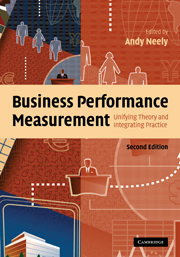Book contents
- Frontmatter
- Contents
- List of figures
- List of tables
- List of boxes
- List of contributors
- Introduction
- Part I Performance measurement – functional analyses and theoretical foundations
- Part II Performance measurement – frameworks and methodologies
- Part III Performance measurement – practicalities and challenges
- Part IV Performance measurement in public services
- 16 Measuring the performance of England's primary school teachers: purposes, theories, problems and tensions
- 17 Police performance: sovereignty, discipline and governmentality
- 18 The development of composite indicators to measure health care performance
- 19 Perversity in public service performance measurement
- Part V Performance measurement – emerging issues and enduring questions
- Index
- References
16 - Measuring the performance of England's primary school teachers: purposes, theories, problems and tensions
Published online by Cambridge University Press: 22 September 2009
- Frontmatter
- Contents
- List of figures
- List of tables
- List of boxes
- List of contributors
- Introduction
- Part I Performance measurement – functional analyses and theoretical foundations
- Part II Performance measurement – frameworks and methodologies
- Part III Performance measurement – practicalities and challenges
- Part IV Performance measurement in public services
- 16 Measuring the performance of England's primary school teachers: purposes, theories, problems and tensions
- 17 Police performance: sovereignty, discipline and governmentality
- 18 The development of composite indicators to measure health care performance
- 19 Perversity in public service performance measurement
- Part V Performance measurement – emerging issues and enduring questions
- Index
- References
Summary
Introduction: background and historical context
The past decade has witnessed a revolution in how public services are managed around the world. Although a variety of slogans and labels, such as “new public management” (NPM; see, for example, Hood, 1991, Dunleavy and Hood, 1994, and Lane, 2000) and “reinventing government” (Osborne and Gaebler, 1992), have been used in different countries to describe their various public sector management reforms, many of the characteristics are similar. Kettl (2000), for instance, identifies six common core ideas: the search for greater productivity; more public reliance on private markets; a stronger orientation towards service; more decentralization from national to “sub-national” governments; increased capacity to devise and track public policy; and tactics to enhance accountability for results.
With regard to national education systems, Moos and Dempster (1998) argue that different countries and different segments of the public sector in those countries have introduced their own forms of new public management, with particular versions being influenced by a combination of historical and cultural conditions, political agendas and economic conditions. However, their analysis of changes in the English, Scottish, Australian and Danish school systems led them to conclude that NPM was characterized in all four by the following five trends.
A movement towards school self-management.
The imposition of greater demands for financial accountability.
An increase in the extent of consumer control over what goes on in schools.
The expectation that schools expose their performance to public scrutiny.
Increasing pressure for outcome-based assessment of pupils, heads and teachers.
- Type
- Chapter
- Information
- Business Performance MeasurementUnifying Theory and Integrating Practice, pp. 339 - 362Publisher: Cambridge University PressPrint publication year: 2007



